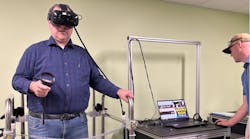What I Learned from Toyota’s Virtual Reality Safety Training in Kentucky
Key Highlights
- Toyota uses virtual reality (VR) tools to train maintenance team members in basic safety hygiene.
- The system reflects Toyota's long history with VR.
- The technology isn't ready for the shop floor but does have uses for production.
I tossed an employee over the edge of a catwalk, ran another over with a forklift, stuck someone’s hands into live wires and, worst of all, told a co-worker to walk down a high stairwell while holding a heavy box!
In virtual reality, obviously.
A recent tour of the Toyota Motor Manufacturing Kentucky (TMMK) plant in Georgetown, about an hour south of Cincinnati, Ohio, began with a visit to its “safety dojo,” where maintenance team members who tend to robots and PLCs among other technology receive training.
“Every plant will have dojos of some kind. It may different from plant to plant. You may have specific shop dojos. Our dojo is one of the first of its kind, as far as fully encompassing maintenance for an entire plant,” says Carter Hall, skilled group leader, die manufacturing at TMMK.
Nestled in the back of the dojo a virtual reality headset, a pair of hand controllers, and a pneumatic lift waited for its first volunteer: Me.
Volunteer VR Safety Trainee
I’m familiar with VR systems (anyone up for some Arizona Sunshine 2?) and strapped the rig around my head quickly. Wearing a VR rig while standing on a pneumatic floor and surrounded by safety chains, however, was something new.
The first simulation placed me on a catwalk high above a manufacturing plant floor. The simulator narrator told me to walk forward and pick up some tools on the other side of the catwalk.
Then, in the real world the floor dropped out from under me. In the simulation, I realized I was staring up at the roof.
“Wasn’t I up there a moment ago?” I said, legs steadying under me. Yes, laughed Hall.
“That stimulus, it’s almost like riding a roller coaster, right? When you go over the end [of the catwalk], you get that feeling of falling. … But we want to do that in a way that’s completely safe. And the VR has really been a great bridge for us to be able to do that,” says Hall.
Next, a forklift ran me over while I picked up an object from the floor of a warehouse. Then, I was the forklift driver. And then, I was an observer watching the accident. Lessons learned: Look around before you stop in the middle of a path and pay attention to where you’re backing up.
I donned a pair of gloves with small vibrating motors that made my hands tingle when I reached into a circuit box without turning the current off – in the simulation, thankfully.
“We try to create as real of a scenario as possible while being 100% safe for our team members,” says Hall.
On Board Early with VR
The first commercial VR units released in 2016, but Toyota deployed VR experiences a year earlier. The TeenDrive365 simulator, designed to run on VR development kit hardware, premiered at the Detroit Auto Show in 2015.
Toyota produced two VR experiences the following year, a Reliability VR demo that simulates how Toyota vehicles handle adverse situations and a VR Prius Prime experience that premiered at Disrupt SF 16. Another app launched in 2019 used VR to teach customers about the new C-HR model.
In 2020, Toyota began using VR for ergonomic validation in the prototype division of its digital engineering department. In 2022, Toyota Motor Manufacturing Indiana deployed the SprayVerse spray painting simulation, still in use at the plant today.
Safety-wise, Toyota Material Handling developed a VR-based safety course in 2021 and according to Hall, Toyota’s “virtual reality dojo” has been used in Japan for the better part of ten years. It was after a trip to Japan for a benchmarking activity that Hall decided he needed a newer version of the technology at the Kentucky plant.
No VR on the Floor, Please
Steve Hitchcock, manager for manufacturing and Industry 4.0, says the plant hasn’t experimented yet with VR on the shop floor, mostly for safety reasons. Plant policy is to not look at smartphones while walking the floor. Wearing head-mounted VR displays in the shop is out of the question.
Instead, production currently leverages VR to simulate new model CAD designs and test ergonomics, such as simulating whether operators can reach into a vehicle with a torque gun, to make sure it fits. Augmented reality (AR) has more efficacy for floor deployments, says Hitchcock, especially when paired with AI.
“Based on data and machine learning [an AI copilot could say] ‘We’ve had these historical things happen before,’ like troubleshooting in a cabinet. The AI could tell you which things to check first. And if the technician has HoloLens he can hit a call button to call up a friend or SME. Now they’ve dialed in someone else who’s watching inside the cabinet and give instructions,” says Hitchcock.
The required computing power also makes VR not a prime candidate for floor deployments.
“Take a full vehicle worth of CAD data, which can take a lot of compute power in order to render those type of images on a VR headset. We are able to do it with a couple components easily right now and put it on the shop floor. But if we do anything heavier than that, we're talking like a heavy duty-graphic super computer to run those type of things. So in order to be able to move that onto the shop floor, into a tiny headset, it just doesn't have the CPU required to do anything significant right now,” says Hitchcock.
VR Isn’t Cheap
To Hitchcock’s point, the expense of a single VR training unit, the VR headset itself, the pneumatic platform and the PC to run the software prevents Hall from expanding use of VR as much as he’d like.
“We don’t have 12 of these stations for a reason [and when] you have the size of our plant [9 million square feet], you have to have a schedule. You have to have an investment of people’s time to get people through training like this…so one of the challenges is always logistics,” Hall says.
Team members who do get access to the training stations have over two hours’ worth of content spread over 10 different virtual scenarios. Hall says there are many more scenarios available, but he keeps things focused on the basics.
“I think what is important for us from a management standpoint, is how can we address the biggest risks and let’s focus on them first. We’ll use the first example, the fall protection. A fall from a height is a catastrophic event. Or being struck by a vehicle…could have catastrophic and life altering consequences. … I want to make sure that we address the first things first,” Hall says.
“As Steve said earlier, lot of moving parts on that assembly floor, so we want to make sure that our team members are diligent. We want to make sure that they’re where they’re supposed to be…wearing proper high visibility PPE, things like that. That’s why we focus top down as far as what is the greatest risk, and how do we address that in the safest way possible?”
About the Author
Dennis Scimeca
Dennis Scimeca is a veteran technology journalist with particular experience in vision system technology, machine learning/artificial intelligence, and augmented/mixed/virtual reality (XR), with bylines in consumer, developer, and B2B outlets.
At IndustryWeek, he covers the competitive advantages gained by manufacturers that deploy proven technologies. If you would like to share your story with IndustryWeek, please contact Dennis at [email protected].



